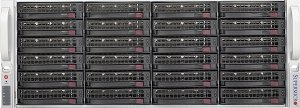Difference between revisions of "- 4. IBM Cloud Scale-out NAS Archive Storage"
m (→Reference Configurations) |
m (→Reference Configurations) |
||
| Line 38: | Line 38: | ||
'''Scale-out NAS Archive Storage Configuration Options''' | '''Scale-out NAS Archive Storage Configuration Options''' | ||
| − | |||
| − | |||
| − | |||
| − | |||
| − | |||
| − | |||
| − | |||
| − | |||
| − | |||
| − | |||
| − | |||
| − | |||
| − | |||
| − | |||
| − | |||
| − | |||
| − | |||
| − | |||
| − | |||
| − | |||
| − | |||
| − | |||
| − | |||
| − | |||
| − | |||
| − | |||
| − | |||
{| class="wikitable" style="width: 100%;" | {| class="wikitable" style="width: 100%;" | ||
|- | |- | ||
Revision as of 16:44, 15 April 2019
Contents
Key Features
QuantaStor’s scale-out block storage configurations provide highly-available iSCSI block storage suitable for a variety of use cases. Each appliance contains SSD to accelerate write performance and each cluster must contain a minimum of 3x appliances. QuantaStor’s web-based management interface, REST APIs and QS CLI make storage provisioning and automation easy.
QuantaStor Scale-out iSCSI Block Storage Features
- S3 & SWIFT Compatible REST API support
- Hybrid HDD + SSD configuration to boost write performance
- Easy web-based management of all appliances with built-in QuantaStor storage grid technology.
- Easy expansion by adding appliances and/or drives.
Expandable
Add additional drives and/or additional appliances to expand capacity. Drives can be different sizes, appliances can have different numbers of drives but for optimal performance uniform drive count and capacities per QS server/appliance are recommended.
Performance
Adding appliances will boost performance as the configuration scales-out. Small 3x appliance configurations will deliver between 400MB/sec and 1.2GB/sec sequential throughput depending on block size and number of concurrent client connections. Erasure-coding is recommended for best write performance and replica mode is recommended for best read performance.
Quick Configuration Steps
Step One: Storage Management Tab → Create Grid → Click OK
Step Two: Storage Management Tab → Add Grid Node → Enter 2nd Appliance IP → Click OK
Step Three: Storage Management Tab → Add Grid Node → Enter 3nd Appliance IP → Click OK
Step Four: Storage Management Tab → Controllers & Enclosures → right-click Controller → Configure Pass-thru devices → Select all → Click OK (do this for each controller on each appliance)
Step Five: Cluster Resource Management → Create Site Cluster → Select All → Click OK
Step Six: Cluster Resource Management → Add Site Interface → Enter IP address for SMB/NFS Access → Click OK
Step Seven: Storage Management Tab → Storage Pool → Create Storage Pool → Create one pool (XFS type) per device per appliance
Step Eight: Scale-out File Storage Tab → Gluster Volumes → Peer Setup → Select all appliances → Click OK
Step Nine: Scale-out File Storage Tab → Gluster Volumes → Create Volume → Enter name, select all Pools and Erasure Coding mode → Click OK
Step Ten: Storage Management Tab → Network Shares → right-click share for volume → Select Modify Share & SMB Access → Adjust access settings → Click OK
Reference Configurations
Scale-out NAS Archive Storage Configuration Options
| Small Tier - Hybrid SAN/NAS – 16TB | Use Cases | System View |
| 2x E5-2620v4 64GB RAM 8x 2TB QS Small Tier (16TB) License 2x 960GB SSDs (write log) 2x 1TB SATA (mirrored boot) 2x 10GbE Private Network ports |
Highly-available block storage for virtualization (VMware, Hyper-V, XenServer) Scale-out block storage with Cinder integration for KVM based OpenStack deployments Highly-available block storage for databases |
| Medium Tier - Hybrid SAN/NAS – 48TB | Use Cases | System View |
| 2x E5-2620v4 128GB RAM 8x 6TB QS Medium Tier License 2x 960GB SSDs (write log) 2x 1TB SATA (mirrored boot) 2x 10GbE Private Network ports |
Highly-available block storage for virtualization (VMware, Hyper-V, XenServer) Scale-out block storage with Cinder integration for KVM based OpenStack deployments Highly-available block storage for databases |
| Large Tier - Hybrid SAN/NAS – 128TB | Use Cases | System View |
| 2x E5-2650v4 128GB RAM 16x 8TB QS Large Tier License 2x 960GB SSDs (write log) 2x 1TB SATA (mirrored boot) 2x 10GbE Private Network ports |
Highly-available block storage for virtualization (VMware, Hyper-V, XenServer) Scale-out block storage with Cinder integration for KVM based OpenStack deployments Highly-available block storage for databases |
| Extra-large Tier - Hybrid SAN/NAS – 256TB | Use Cases | System View |
| 2x E5-2650v4 256GB RAM 32x 8TB QS XL Tier License 2x 960GB SSDs (write log) 2x 1TB SATA (mirrored boot) 2x 10GbE Private Network ports |
Highly-available block storage for virtualization (VMware, Hyper-V, XenServer) Scale-out block storage with Cinder integration for KVM based OpenStack deployments Highly-available block storage for databases |

